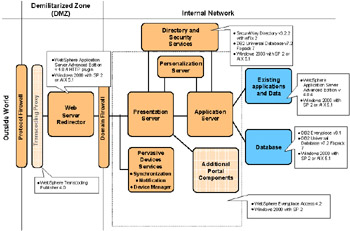Chapter 5: Selecting the Product Mapping
After choosing the appropriate runtime pattern, it is time to map the Runtime pattern and map the products used to implement it.
A product mapping maps the logical nodes defined in the Runtime pattern to specific products which implement the Runtime solution design on a selected platform. The Product mapping identifies the platform, software product name , and often version numbers as well.
5.1 Product mappings
The next step after choosing a Runtime pattern is to determine the actual products and platforms to be used. Selecting products means selecting hardware and software elements as well. Choosing the right elements is always difficult because of various considerations which must be taken into account. In some cases, decisions are made considering not only the technical and logical points but other factors such as expenses, existing knowledge, or time. The platform chosen should fit into the customer's environment and ensure quality of service, such as scalability and reliability, so that the solution can grow along with the e-business.
5.1.1 Pervasive Portal solution framework
The products used to implement a Pervasive Portal solution in this redbook includes the WebSphere product family running in a heterogeneous Microsoft Windows 2000 and IBM AIX environment.
5.1.2 Product mapping for Pervasive solutions
Product mappings are shown for:
-
Pervasive Device Access Runtime pattern: Variation 1
-
Portal composite pattern runtime variation for Pervasive solutions
Product mapping for Pervasive Device Access Runtime pattern: Variation 1
The product mapping for this runtime supports the basic runtime and the variation for security and addressing the Windows and AIX platforms.
This product mapping represents the Pervasive Device Access pattern with the separation of the Web presentation server and the application server, providing a more secure, scalable and reliable architecture as described in the Access Integration pattern section, "Pervasive Device Access Runtime pattern: Variation 1" on page 49.

Figure 5-1: Pervasive Device Access Runtime pattern Variation 1 product mapping
Although this product mapping is focusing on enabling an existing application for Pervasive devices and does not include portal components , it still requires the portal server to run system management services, such as Intelligent Notification.
Portal composite pattern runtime variation for Pervasive solutions
The product mapping for this runtime is based on the Portal composite runtime pattern, additionally it supports the pervasive device access and addresses the Windows and AIX platforms.

Figure 5-2: Portal composite pattern runtime pattern variation for Pervasive
Protocol mapping
The protocol mapping in Figure 5-3 on page 59 represents the protocols used to communicate between the nodes and the applications.

Figure 5-3: Protocol mapping
As shown in Figure 5-3, the network protocols used for the Windows implementation are as follows :
-
HTTP/HTTPS: Hypertext Transfer Protocol (HTTP) and Hypertext Transfer Protocol Secure (HTTPS) are used from the user 's Web browser to the HTTP server in the Web server redirector node.
HTTP or HTTPS are also used from the WebSphere Web server plug-in in the Web server redirector node to the Web container in the presentation server node, as well as from the collaboration and content management node to the presentation server node.
-
LDAP/LDAPS: the presentation and application server uses Lightweight Directory Access protocol (LDAP) to access the LDAP server in the Directory and Security Services node. LDAPS is the secure LDAP connection to a directory server using SSL. Since LDAP directories store essential and sensitive applications and business information, the communication can use LDAPS to be secure.
-
SMTP: the notification server can use the SMTP protocol to send messages (mail) to the clients . Using SMTP gateways, the mail or message can be transmitted through different protocols and transports, for example SMS (GSM network).
-
JDBC: the Application Server node and the Directory and Security Services node uses a Java database connectivity (JDBC) driver to access the Database Server node.
-
RMI/IIOP: the Personalization Server node uses Remote Method Invocation (RMI) over Internet Inter-Orb Protocol (IIOP) to access the EJB container in the Presentation Server node and the EJB container in the Application Server node.
RMI/IIOP is also used from the Presentation Server node to the EJB container in the Application Server node.
EAN: 2147483647
Pages: 83